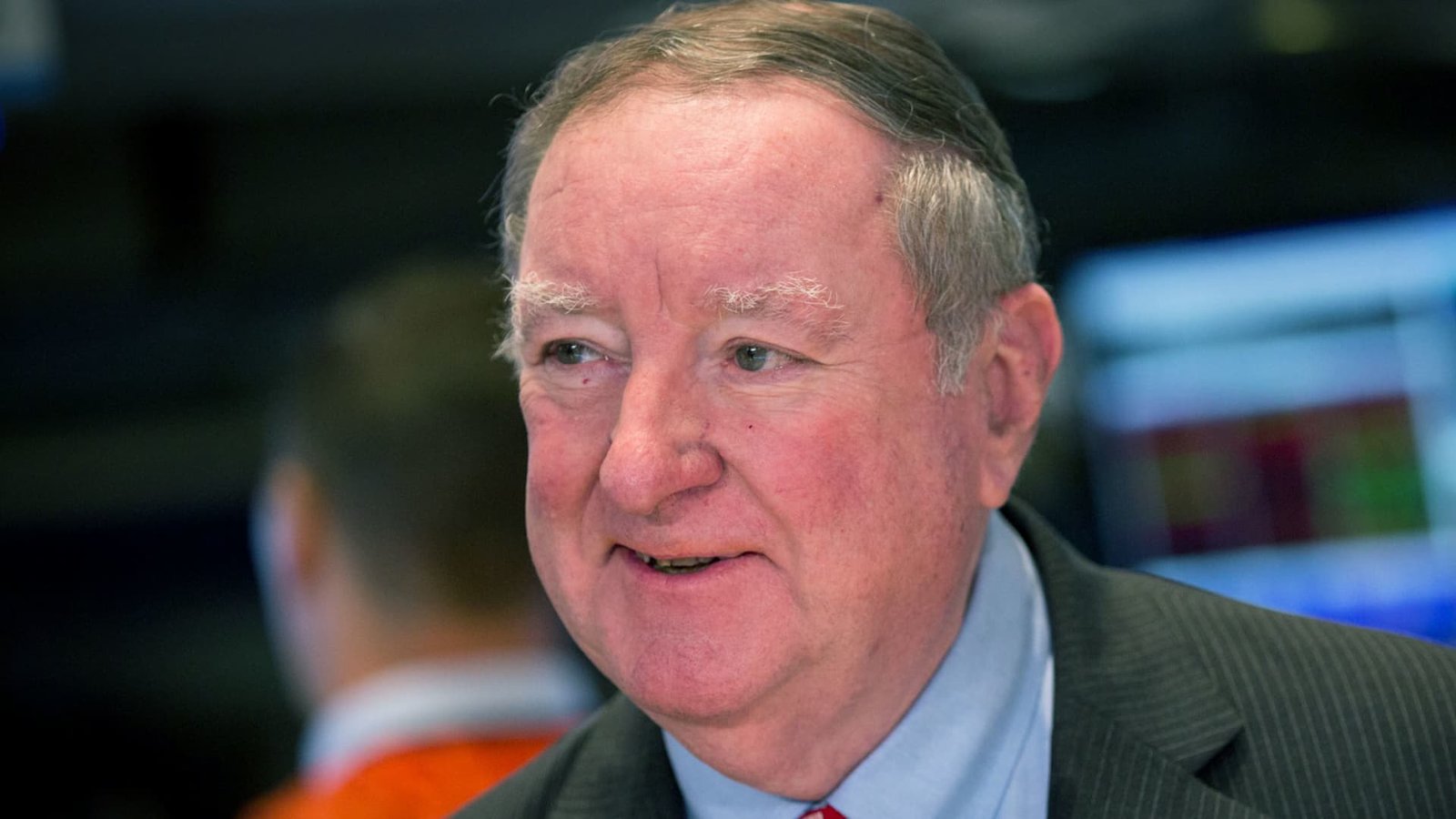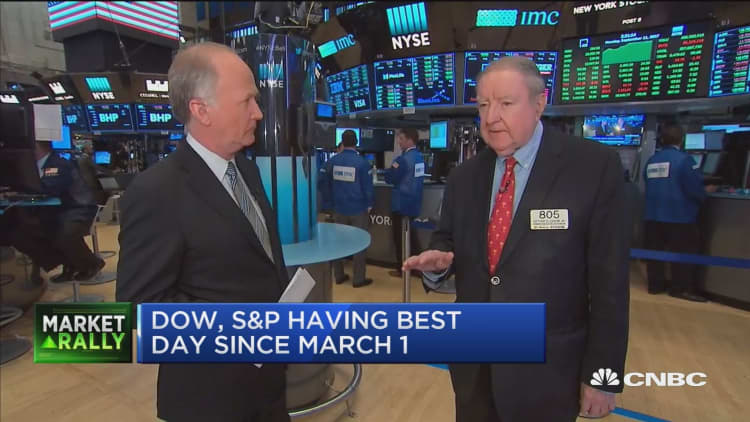Physical Address
304 North Cardinal St.
Dorchester Center, MA 02124
Physical Address
304 North Cardinal St.
Dorchester Center, MA 02124


Art Cashin, UBS’s director of floor operations at the New York Stock Exchange and the man The Washington Post called “Wall Street’s version of Walter Cronkite,” has died. He was 83 and a regular on CNBC for more than 25 years.
In the fiercely competitive and often cutthroat world of stock market commentary, Cashin was that rarest of creatures: a man respected by bulls and bears, liberals and conservatives alike. He seemed to have almost no enemies.
He was a heavy drinker and a wise man, a story teller.
For decades, he gathered a group of like-minded friends every day after the trading halt, first at the bar of the NYSE Lunch Club, then across the street at Bobby Van’s Steakhouse, where the group became known as “Friends of Fermentation.” “. His drink was Dewar’s, always on the rocks.

Kashin’s success was due to charm, wit, intelligence and a stubborn insistence on refusing to accept many of the comforts of the modern world. He was a link to the NYSE tradition. Every year on Christmas Eve and New Year’s Eve, he led the singing of the 1905 song “Wait ‘Till the Sun Shines, Nellie.”
Cashin refused to use credit cards and paid for everything, especially the hefty bar bills, with cash, saying he cherishes his anonymity. He never learned to use a computer – his notes were written by hand and then sent to his assistant. For years he used an antiquated flip phone that he rarely answered.
His desk was full of papers he had accumulated over the decades. At times it resembled a recycling plant.
Kashin’s suits were usually wrinkled, and his ties were always out of date.

However, neither his appearance nor his attitude was accidental. It was part of a personality that had been carefully cultivated over 50 years on Wall Street.
Arthur D. Cashin Jr. was born in Jersey City, New Jersey in 1941. His parents were supervisors of an apartment building. His business career began in 1959 at Thomson McKinnon, a brokerage firm, when he was 17 years old and still in high school. Kashin had to join the workforce when his father died unexpectedly that year.
Art Cashin and CNBC’s Bob Pisani discuss the stock market from the NYSE floor in 2013.
In 1964, at the age of 23, he became a member of the NYSE and a partner of PR Herzig & Co.
At the time, most trading took place on the floor of the NYSE. Kashin’s early memories revolve around the noise of thousands of brokers shouting at each other. He claimed he could tell if the market was going up or down by the volume of the yelling, as the sellers sounded panicky. “And so if the noise level was high, I’d know the sellers were coming my way. Or if it was rumbling, I’d know the buyers might be coming,” he said in a 2018 interview.
In the mid-1970s, disgusted by the corruption in his hometown of Jersey City, Cashin ran for mayor. “I think I finished 12th in a field of five,” he said. “But once they found out I was honest, I didn’t have much of a chance of getting elected.”
He returned to Wall Street. He joined PaineWebber in 1980 and managed its floor operations, continuing to do so after PaineWebber was bought by UBS in 2000.
Then came 2001.
Cashin often recalled what it was like to flee Ground Zero on Sept. 11, 2001, after terrorists crashed two jetliners into the World Trade Center towers, killing more than 2,600 people in the heart of the nation’s financial center.
“Many of us got out that Tuesday, walking through the streets, on which ash, smoke and business envelopes fell like snow, obscuring both the view and the breathing.” he wrote in a comment 13 days later. “However, when a stranger was met, they were invited to join the caravan and offered a spare wet cloth (carried in their pockets) to breathe through as they walked. When we reached the East River (on the Brooklyn side of Manhattan) there was a group of volunteer tugboats, fishing boats and mini ferries , which looked like the evacuation of Dunkirk. Only no name will be sent. But Americans – even New York Americans – who give freely to strangers but arguing with neighbors suddenly became one group.we all internalize the survivor problem.we are lucky to be alive but why us.

After the 9/11 attacks, Cashin chaired the NYSE’s Fallen Heroes Fund, which awarded millions of dollars to the families of first responders killed in the line of duty.
Although he was a respected market historian, he was most famous as a stock market storyteller. He kept a close eye on fundamental and technical trading patterns, but never let the data get in the way of explaining the market in a vernacular way that made it accessible to even the casual observer. He often spoke of Wall Street as a community of people with different opinions. In his world, the bulls and bears would battle it out every day as if it were all a John Wayne western: “The bulls circle the wagons trying to defend the heights” was a common refrain.
Art Cashin, managing director of UBS Financial Services, speaks to CNBC in 2019.
CNBC
His daily market commentary, “Cashin’s Comments,” was distributed continuously to clients for over 40 years and was widely read on Wall Street. It always began with an analysis of an important event that occurred on that date (“On this date in 1918, the United States defeated the worldwide influenza epidemic”), and after a brief history lesson, that event was linked to the market for that day. events (“U.S. stock futures looked like they might have the flu ahead of the open on Wednesday morning. Several earnings reports were less than glowing, with some clouding the outlook”).
He was a keen observer of human behavior, a behavioral psychologist long before the word was coined. He had seen his fellows panic from time to time, and he had seen the consequences of the initial desire to sell without thinking. “It tells me that people tend to overreact and not think carefully,” he said. “And you again divide into two groups of people: those who look at events with a certain suspicion, and others who say, “Oh, I have to react to this.” Those who react immediately rarely do well.
He had two great loves in his life: his family and the New York Stock Exchange. In the era of computerized trading, the fabled NYSE trading floor still remains, though much degraded. When it was closed during the Covid pandemic, he said he was “disappointed…but understandable“.
Art Cashin with Santa at the NYSE in 2013.
Source: NYSE photo
Kassin was philosophical when asked about the rise of electronic trading, which has slowly but surely eroded that floor’s influence. “I miss the glorious day when your spirit surrendered to the fact that you’ve made good on your word or you’re out of here,” he once told Bobby Van’s, but acknowledged that electronic trading has improved the speed and accuracy of trading because especially. record keeping.
Among his many friends, he will probably be best remembered for his modesty. He seemed genuinely confused about his popularity. “People are interested in Arthur Cashin. I can’t quite understand why,” he said.
And when The Washington Post ran a lengthy profile of his career in 2019, calling him Wall Street’s version of CBS’s Cronkite, he quipped, “I think I owe Walter Cronkite an apology.”
In lieu of flowers, the family welcomes donations to the Arthur D. Cashin Jr. Memorial Scholarship at Xavier High School. Contributions can be sent to Xavier High School, 30 West 16th Street, New York, NY 10011.
— CNBC Martins Steinbergs contributed to this report.